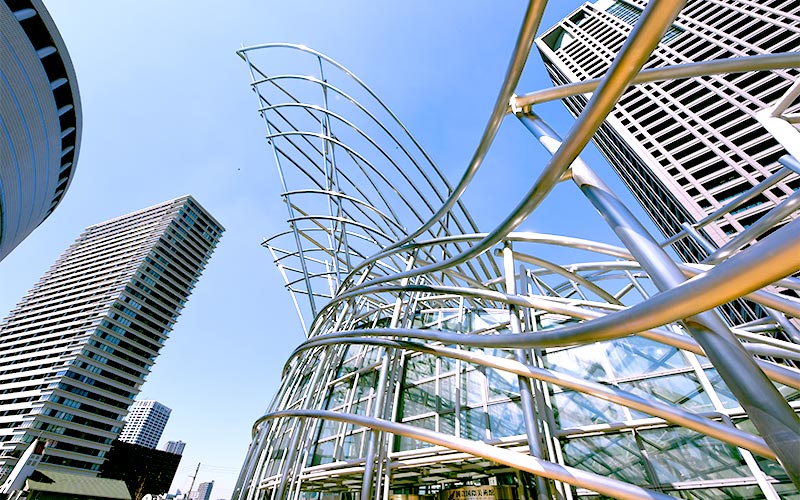Museum History

When it opened on October 15, 1977, the museum became Japan's fourth national museum. The building was partially renovated after originally serving as the Expo Museum of Fine Arts at Expo'70, but unlike the other pavilions, it was originally designed to be a permanent structure. Moreover, the site was originally scheduled to serve as home to the Osaka Prefectural Museum of Contemporary Art, but due to financial difficulties and the election of a new governor, the plan was ultimately shelved. Later, the idea of building a national museum gained support, and while studying already existing national museums, the facility was approved. The main objective of the museum was "to collect, store, and publicly display the artworks and resources, and conduct the related research and other projects needed to elucidate the relationship between developments in Japanese art and art from the rest of the world."
This objective, however, proved to be overly inclusive, and attempting to collect the appropriate works from throughout history and around the globe was extremely difficult.
Limited by budget constraints, some of the original plans included collecting photographic reproductions of famous works from Japan and abroad, buying photographic reproductions of painting by Paul Cezannne, Van Gogh, and Paul Gauguin and print reproductions of "Ukiyo-e", and commissioning the photographer Yasuhiro Ishimoto to photograph Claude Monet's water lilies. All of this was part of an effort to stage exhibitions of reproductions. One remnant from the period are the 117 photographs by Ishimoto that make up Den-shingonin-mandala. At the same time, the museum began to collect comparatively easy-to-obtain contemporary works, which helped determine our later direction.
With only a very few works in the collection at the time of the museum's opening, including a ceramic mural by Joan Miro and a bronze sculpture by Henry Moore, it wasn't yet possible to hold adequate exhibitions, so the collection was temporarily supplemented with works from the National Museum of Modern Art, Kyoto, and huge photographic panels of Claude Monet's water lilies. But in 1978, One Part (828works) of the chemist and businessman Kaichi Ohashi's massive art collection was donated to the museum by his bereaved family, and as of that fiscal year, the total number of works suddenly jumped to 1,208. Of these, 225 were paintings, 586 were prints, and 17 were sculptures. Among the prints were 475 works by Yukihisa Isobe and 64 monotypes by Arinori Ichihara, while the painting collection included works by Nobuya Abe, Tadashi Sugimata, Tatsuoki Nambata, Toshimitsu Imai, Mokuma Kikuhata, Kazuo Shiraga, Sadamasa Motonaga, Georges Mathieu, and Paul Jenkins, and sculptures by Kentaro Kimura and Bushiro Mori. All of the works were produced between the late 50s and the 60s, so with the help of the Ohashi collection the museum was able to assemble a strong core of art representing the postwar era.
The collection continued to grow little by little, and by 1982, had exceeded 2,000 works. A group of over 150 copperplate prints by Yozo Hamaguchi that were acquired over a three-year period beginning in 1983 represented a nearly complete collection of the artist's output. And as of our 20th anniversary in 1997, the museum had amassed 2,931works. From1998, we began to acquire Hamaguchi's later works, missing prints, and 186 sketches, 447 prints and sketches by Keiko Minami, and received a large donation of 722 posters by Tadanori Yokoo. By actively trying to expand the collection, over the last ten years, the museum has increased its holdings by 2,822 works.
As of March 2011, The National Museum of Art, Osaka, boasted a total of 6,109 works. Some 2,190 (or more than the third) of these are prints. By expanding the definition of the word to include graphic design works such as Yokoo's posters, over half of the entire collection might be said to consist of about 3,000 prints. And as another 751 works are watercolors or sketches and 605 are photographs, all of which employ a paper support, one might also say that about 70 percent of the collection shares a paper medium. On the other hand, the remaining 30 percent includes 593 paintings, 26 of which are "Nihonga" (Japanese-style painting), 319 sculptures, 76 crafts, and a small amount of industrial design works such as furniture and lighting fixtures.
Our collection of 633 educational materials is primarily made up of the aforementioned Reproductions of "Ukiyo-e" prints.